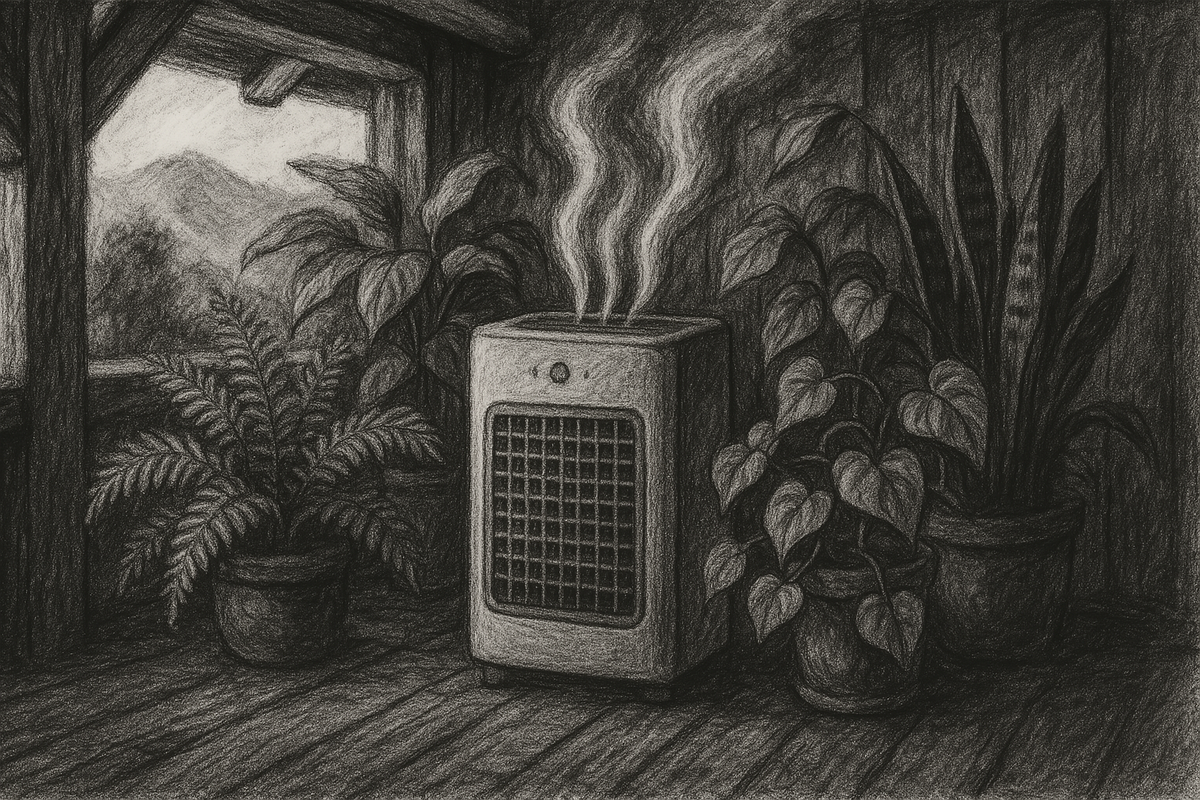Breathing Easy: Why Air Purifiers Trump Plants Every Time

How effective are Air Purifiers?
Air purifiers are designed to mitigate indoor air pollution by removing particulate matter (PM), allergens, mold spores, and volatile organic compounds (VOCs). Multiple academic studies underscore their effectiveness in improving indoor air quality and health outcomes. A study published in ScienceDirect conducted a randomized, double-blind, crossover intervention trial involving 105 elementary school pupils in Mengzhou, China, to evaluate air purification in living rooms and classrooms (Evaluating the effectiveness of air purification). The results showed purification efficiencies of 32.5%–54.8% in living rooms and 81.6%–92.4% in classrooms, with personal PM2.5 concentrations reduced by 42.31% (95% CI: 45.28%, 39.17%) in living rooms and 21.34% (95% CI: 24.89%, 17.61%) in classrooms. This highlights their significant impact on reducing fine particulate exposure, which is critical for respiratory health.
Another study from PMC emphasized the role of HEPA filters, traditionally used in hospitals, in home air purifiers (Enhancing indoor air quality – The air filter advantage). HEPA filters have a minimum efficiency of 99.97% for particles ≥0.3μm, meaning for every 10,000 particles of this size, only 3 pass through, with the rest trapped. This mechanical filtration is effective for capturing airborne allergens and particles, as demonstrated by van der Heide et al. (1997), who assessed air cleaners' capacity to capture allergen particles over 6 months, showing substantial reductions (Enhancing indoor air quality – The air filter advantage).
Health benefits are also well-documented. A study by Francis et al. (2003) found that HEPA air cleaners improved bronchial reactivity and treatment requirements for 30 adult asthmatics, indicating improved asthma outcomes (HEPA air cleaners for asthma). For cardiovascular health, Bräuner et al. (2008) showed that particle-filtered air improved microvascular function by 8.1% (95% CI: 0.4-16.3%) after 48 hours in 21 non-smoking couples, suggesting reduced cardiovascular risk (Particle-filtered air and cardiovascular health). These findings collectively suggest air purifiers are a robust solution for managing indoor air quality, particularly for those with respiratory or cardiovascular conditions.
Plants as Alternatives to Air Purifiers
The notion of plants as natural air purifiers stems from studies like NASA's Clean Air Study, which tested 19 plant species for their ability to remove pollutants like formaldehyde, benzene, and trichloroethylene in sealed chambers (Interior landscape plants for indoor air pollution abatement). For instance, Wolverton's 2006 study found that golden pothos reduced benzene and trichloroethylene from 36 ppm to barely detectable levels in a 0.58 cubic yard chamber within 2 hours, showcasing potential in controlled environments (How to Grow Fresh Air). Additionally, Kays et al. tested 86 species and found ferns like Osmunda japonica had high formaldehyde removal efficiency, supported by enhanced dehydrogenase activity with air circulation (Variation in formaldehyde removal efficiency among indoor plant species).
However, these findings are controversial when applied to real-world settings. A 2019 meta-analysis by Cummings and Waring, published in Journal of Exposure Science & Environmental Epidemiology, reviewed 12 studies and 196 experimental results, translating outcomes into clean air delivery rates (CADR, m³/h) (Potted plants do not improve indoor air quality). The median single-plant CADR was 0.023 m³/h, necessitating 10–1,000 plants/m² to match the VOC removal rate provided by typical outdoor-to-indoor air exchange (~1 h⁻¹). This impractical density (e.g., 680 plants in a 1,500 sq ft space) undermines plants' viability as alternatives. The American Lung Association echoed this, noting that studies in small, airtight chambers do not reflect natural indoor environments, where ventilation dilutes pollutants (Houseplants don’t clean air).
Moreover, plants can introduce risks. Overwatering may lead to mold, triggering allergies and asthma, while dust on leaves or pests like aphids can worsen respiratory issues. Certain plants, such as ferns and weeping figs, may exacerbate allergies, as noted by the American Lung Association (Mold and indoor air pollutants). Thus, while plants offer aesthetic and psychological benefits, their air-purifying capacity is limited, making them supplementary rather than substitutive to air purifiers.
Necessity of Air Purifiers
The need for air purifiers varies based on indoor air quality, health status, and pollutant exposure. Academic and governmental sources outline specific scenarios where they are beneficial. For allergies and asthma, a study cited by Healthline found HEPA purifiers reduce indoor allergens like pollen and dog dander, though less effective for settling particles like dust mites, with 8/10 people exposed to dust mites and 6/10 to cat/dog dander (Do Air Purifiers Work). The EPA recommends air purifiers as a third option after source control and ventilation, noting indoor air can be 2–5 times more polluted than outdoor air (Improving Indoor Air Quality).
For mold, air purifiers remove airborne spores but do not address moisture sources, crucial for asthma patients, especially children (Guide to Air Cleaners in the Home). Smoke, whether from tobacco or wildfires, is another concern; air purifiers reduce smoke particles, with a study showing effectiveness for landscape fire smoke but limited for tobacco nicotine (Residential Air Cleaners - A Technical Summary). For VOCs, activated carbon filters are necessary, as HEPA alone is ineffective, and source control (e.g., non-toxic cleaners) is vital (Household Air Pollution and Health).
Health conditions like cardiovascular issues also warrant air purifiers. A study by Allen et al. (2011) found air filters reducing indoor fine particles by 60% increased reactive hyperemia index by 9.4% and decreased C-reactive protein by 32.6%, improving endothelial function (Air filters and cardiovascular health). The UMass Amherst Environmental Health & Safety fact sheet recommends HEPA filters (MERV 13+) for particles and aerosols, emphasizing regular filter replacement for optimal performance (Air Purifiers Fact Sheet).
To illustrate, here is a table summarizing key scenarios and effectiveness:
Air purifiers are most effective when integrated with ventilation, humidity control, and housecleaning. Recommended specifications include HEPA filters (MERV 13+), CADR at least 2/3 room area (higher for wildfire smoke, equal to room sq ft), and targeting specific contaminants. For instance, consult a doctor for underlying health issues and look for certified devices at asthmaandallergyfriendly. Consider an air quality home test first at Healthline to assess needs.
Conclusion
Air purifiers are effective tools for improving indoor air quality, with robust evidence supporting their role in reducing PM, allergens, and health risks, particularly for asthma and cardiovascular conditions. Plants, while offering some air-purifying benefits, are not practical alternatives due to the impractical number required and potential risks like mold or pests. The necessity of air purifiers depends on individual circumstances, such as allergies, asthma, mold, smoke, or poor air quality, and should be part of a comprehensive strategy including source control and ventilation. For those considering an air purifier, selecting a device with HEPA and activated carbon filters, appropriate CADR, and regular maintenance ensures optimal benefits, tailored to specific indoor environments and health needs.
Key Citations
- Evaluating the effectiveness of air purification in real-world living and learning environment
- Enhancing indoor air quality – The air filter advantage academic study
- HEPA air cleaners improve asthma control in adults study
- Efficiency of Air Purifiers at Removing Air Pollutants in Educational Facilities
- Potted plants do not improve indoor air quality review and analysis
- Interior landscape plants for indoor air pollution abatement NASA study
- How to Grow Fresh Air 50 Houseplants That Purify Your Home or Office book
- Variation in formaldehyde removal efficiency among indoor plant species study
- Houseplants don’t clean air American Lung Association blog
- Do Air Purifiers Work Research Best Practices and More health article
- Guide to Air Cleaners in the Home EPA document
- Residential Air Cleaners - A Technical Summary EPA report
- Household Air Pollution and Health WHO fact sheet
- Improving Indoor Air Quality EPA guidelines
- Air Purifiers Fact Sheet UMass Amherst environmental health




Comments ()